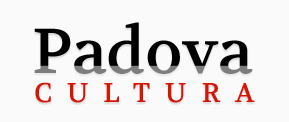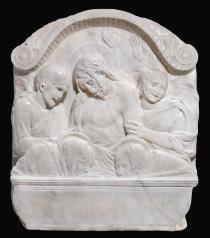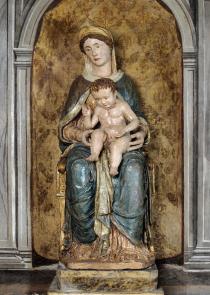Donatello's Heritage
Observations about sculpture and goldsmithery in Padua between the Fourteenth and Fifteenth centuries
The attribution of a previously uncredited work to Donatello, after being confirmed following careful restoration, the Croce (Cross) - an outstanding item of the Museo Diocesano - in the church of Santa Maria dei Servi, gives Musei Civici food for thoughts about the Florentine master’s activity in Padua and his influence on the local artistic environment. Such an insight can be accomplished through a selection of works by Donatello himself, Bartolomeo Bellano, Giovannni de Fonduli, Andrea Briosco and Severo da Ravenna. These works come from city collections, churches and some items from private collections. The artists who followed his style preferred marble, terracotta, bronze with a special inclination for sculpture.
Donatello reached Padua in 1443-1444 and lived there for a decade. His presence turned Padua into one of the most relevant Renaissance towns and his style was influenced by a somewhat overdue naturalism with a late-Gothic feature. His prospectic knowledge allowed him to resolve volume/space issues with the same mastery as in painting. He proved to be a virtuoso in recovering classical subjects, especially late period expressionist features and horror vacui.
One of his apprentices was Bartolomeo Bellano, born in Padua about in 1437-1438. As a young boy he joined Donatello’s workshop and followed the master to Florence. Bellano contributed to the master’s last works and completed them with Bertoldo di Giovanni’s help. In the Bible history reliefs for Sant’Antonio presbytery, which were melted in the second half of the eighties of the fourteenth century, he demonstrates to be a skilled story-teller of choral episodes. In their original location these reliefs are difficult to be interpreted; however the short-distance set-up of this exhibition allows the audience to appreciate the author’s highest level of expertise in his mature age.
Following Donatello’s activity in Padua, a considerable output of terracotta items can be traced. Giovanni and Agostino de Fonduli’s workshop stands out. San Giovanni’s fine statue testifies the birth of a mutual language in which the activity of the greatest Northern-Italy bronze artist, Andrea Briosco, known as Riccio (1460-1532) is involved. He was the artist who completed the Roccabonella monument that Bellano left unfinished. The Madonna at the Ca’ d’oro in Venice was manufactured in this span of time. His expressionistic-based models achieve ancient and classicist rigor, whose instances can be seen in the terracottas with San Canziano, San Girolamo and Sant’Agnese (or Canzianella) in the church of San Canziano in Padua. These statues carry on a wider project that Bellano had started with the statue of Sant’Anna.
The first decade of the fifteenth century was probably the time when Riccio and Severo da Ravenna cooperated the most. The latter was the author and supporter of a wide range of classical subjects and he started the manufacture of small bronze artefacts. Between 1520 and 1530 some polychrome terracotta masterpieces are dated, such as the Madonna of the Scuola del Santo and the Testa di Madonna at the Museo Padovano. These works contain an ample range of elements taken from the study of classical antiquity.
The group which completes this part of the exhibition dates back to the last period, 1530. It is the Compianto in terracotta for the church of San Canziano, namely two statues of weeping Mary. Briosco, following Guido Mazzoni’s standards, blends his mastery for the use of colours with a light accademicism: large surfaces with chiaroscuro definition - due to deep engravings - lights up a dramatic patheticism.
Donatello’s influence was remarkable in craftsmanship, too, especially in goldsmithery. At the temporary exhibition areas in Palazzo Zuckermann a wide selection of pieces of church jewellery belonging to the fourteenth and fifteenth centuries - reliquaries and cultural items exceptionally borrowed from the Santo’s treasury - are shown.
Info:
City Museums
Piazza Eremitani 8, Padova
tel. +39 049 8204551
opening times: throughout the year: 09:00-19:00
Palazzo Zuckermann, Corso Garibaldi 33
tel. +39 049 8205664
opening times: throughout the year: 10:00-19:00
all Museums are closed on: Mondays (unless public holidays), January 1, May 1, December 25-26
tickets: full-price 10.00 euro;
reduced price: 8.00 euro groups of minimum 10 persons, young people of 18 to 25
musei@comune.padova.it
http://padovacultura.padovanet.it/it/musei
All Entry tickets must be purchased from the City Museums office in Piazza Eremitani 8
How to reach City Museums and Palazzo Zuckermann:
from train station: buses nos. 3/ 10/ 12; on Sundays and public holidays: buses nos. 42; metrotram;
by car and coach: motorway exit Padova Est: Fairgrounds car park, shuttle bus service to centre of town
motorway exits Padova Sud and Padova Ovest: car park in ex-Foro Boario (Prato della Valle), shuttle bus service to centre of town; Via D. Valeri (off Via Trieste); Piazza Insurrezione (from 10.00, limited space).
Musei Civici agli Eremitani, piazza Eremitani 8
tel. +39 049 8204550 - 51
fax +39 049 8204585
orario: tutto l'anno 09:00 - 19:00 - See more at: http://padovacultura.padovanet.it/it/musei/museo-darte-medievale-e-moderna#sthash.1fiPuvtY.dpuf
Musei Civici agli Eremitani, piazza Eremitani 8
tel. +39 049 8204551
orario: tutto l'anno 09:00-19:00
chiusura: tutti i lunedì non festivi, Natale, S.Stefano, Capodanno
ingresso: intero euro 10,00; ridotto euro 8,00 (con biglietto mostre di Castelfranco e Bassano riduzione con reciprocità); ridotto speciale euro 6,00 bambini e ragazzi dai 6 ai 17 anni, studenti universitari, gruppi di studenti accompagnati da insegnanti, comitive di almeno 10 persone iscritte ad associazioni con finalità socio culturali, militari di leva, over 65 cittadini UE; ridotto scuole euro 5,00; gratis portatori di handicap e bambini fino ai 5 anni
- See more at: http://padovacultura.padovanet.it/it/musei/veronese-e-padova#sthash.igk2gDt6.dpuf









Add new comment